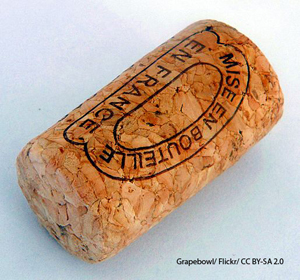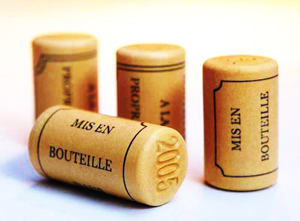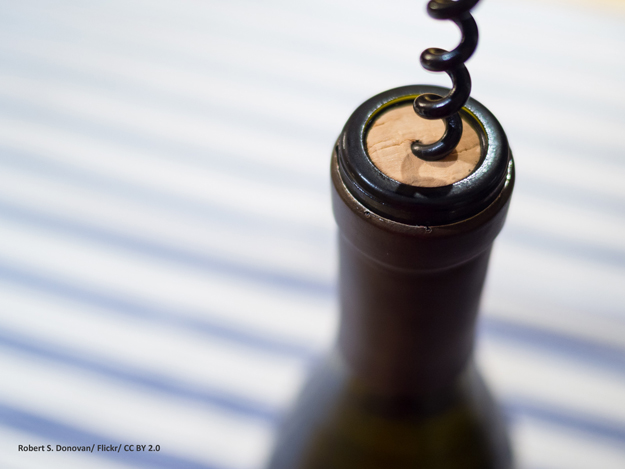If you’re like a lot of people, a screw cap on a bottle of wine might conjure up images of Boone’s Farm or Mad Dog 20/20. Wine enclosures have traditionally been cork, so a screw cap – or even a glass or plastic stopper – can be a bit off-putting for some people. But here’s the thing: Over the years, winemakers have found different ways of closing up wine bottles. They’re all effective and some are better for certain wines than others. So the important thing is not to be scared to buy any of them!
Let’s take a look at the different kinds of closures and the differences between them.
Cork
Cork use can be traced all the way back to the ancient Egyptians, but as late as the mid-17th century, vintners in Europe stuffed oil-soaked rags or hemp wrapped around cones into bottles  of wine to stop up wine bottles. That doesn’t sound all that appetizing, so luckily people started using cork stoppers.
of wine to stop up wine bottles. That doesn’t sound all that appetizing, so luckily people started using cork stoppers.
The advantage of cork is that it’s elastic, resilient, buoyant, and impermeable, and it keeps an airtight seal. Cork is also natural. Cork has been used for so long to seal wine bottles because, until the past couple of decades, it really has been uniquely suited for the task.
Some vineyards even grow their own cork trees and produce corks for use with their wines.
Occasionally, a cork can leave a musty or moldy taste and smell in a wine. When this happens, the wine is said to be “corked” or “corky”. Cork taint won’t hurt you, but it certainly spoils the wine experience, and thus the wine. The good news is that a very small percentage of bottles are corky. Chances are you won’t get one, but if you do, for instance, when you’re dining out, don’t be afraid to ask the waiter to send it back.
Synthetic
Synthetic corks – made of plastic – have a big advantage for winemakers: they cost less. They  also do a good job of sealing the bottle and there are virtually no cork taint issues. Another advantage of synthetic stoppers is that they can be made in a variety of colors, which can be a plus when marketing wines.
also do a good job of sealing the bottle and there are virtually no cork taint issues. Another advantage of synthetic stoppers is that they can be made in a variety of colors, which can be a plus when marketing wines.
A downside of synthetic corks is that they’re more difficult to remove and hard to put back into the bottle. Synthetic corks are not biodegradable, but some are recyclable.
Glass stoppers
Glass stoppers look cool. But they’re practical as well. The stopper is held in place by a resin ring that keeps a tight seal. And glass stoppers are recyclable. The downside is cost – glass stoppers are pricier than cork, synthetic or screw tops so they aren’t as widely used.
Screw caps
The screw cap, also known as the Stelvin, has several advantages: No cork, so no cork taint; it’s  easy to open; it’s cheaper than cork; and it prevents the wine from getting too much oxygen.
easy to open; it’s cheaper than cork; and it prevents the wine from getting too much oxygen.
The first wines to use screw caps came from New Zealand and Australia. The screw cap’s biggest problem is image, although that has been changing in recent years and screw caps are starting to gain some respectability. Don’t dismiss a wine simply because it has a screw cap!
Which closure is best?
Wine is a highly experiential activity. Neither synthetic nor screw cap can duplicate the sound of a natural cork coming out of the bottle with a satisfying “thunk,” before being poured into a glass for tasting. Aside from personal preference, however, no one closure is perfect for all wines.
A good rule of thumb: Wines that require a good deal of aging will do best with a cork – it allows enough oxidation to age the wine properly. Wines that don’t require a lot of aging will be perfectly fine with a synthetic, screw-top or glass stopper.
In the end, the closure should have no bearing on what wine you buy. The important thing is the taste. If you like the wine, how the bottle is closed should make no difference at all!
♦
Whether natural or synthetic cork, glass stopper or screw cap, we have wine with every kind of closure! Check out our huge selection at https://www.liquorandwineoutlets.com/wine.
